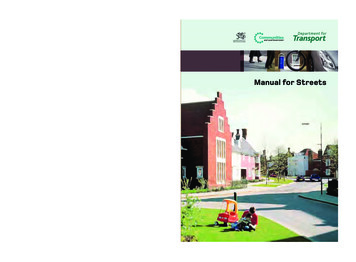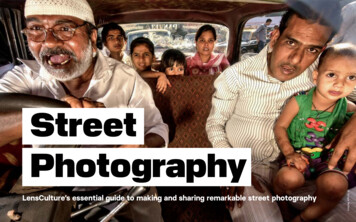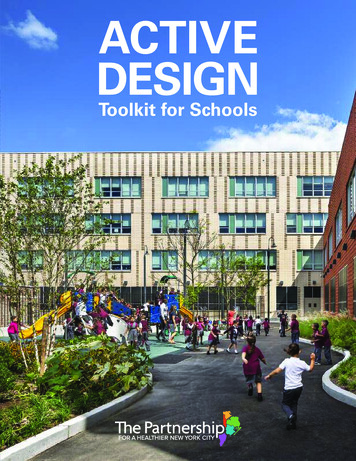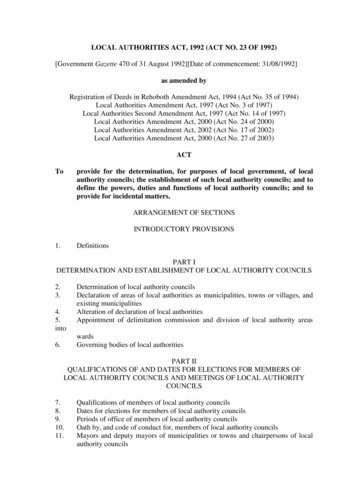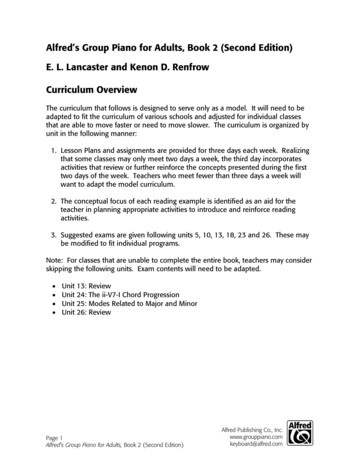
Transcription
Complete Streets Work GroupFinal ReportSPN 736‐99‐1478Prepared for:The Louisiana Department ofTransportation and DevelopmentPrepared by:July 2010
Final Report for Secretary of the Department of Transportation andDevelopmentPrepared by Burk‐Kleinpeter, Inc.7/30/2010
This page intentionally left blank
COMPLETEL O U I S I A N ASTREETSD E P A R T M E N TO FWORKT R A N S P O R T A T I O NA N DGROUPD E V E L O P M E N TTable of ContentsAcknowledgements. iiiProject Management . iiiWork Group Members . iiiLouisiana Department of Transportation and Development Participants . ivSenate Concurrent Resolution 110 Sponsors . ivLouisiana Department of Transportation and Development Complete Streets Policy . vDefinitions. viiExecutive Summary. ES‐1Introduction . 1What are Complete Streets?. 1What Does a Complete Street Look Like?. 1Defining Complete Streets . 1Costs and Benefits of Complete Streets . 3Benefits of Complete Streets . 3Costs of Complete Streets and Funding Considerations. 6Common Concerns Related to Complete Streets . 9Completing the Streets in Louisiana . 11Louisiana’s Efforts to Complete their Streets . 11Louisiana Statewide Bicycle and Pedestrian Plan, 2009 . 11Senate Concurrent Resolution 110 . 11How do the Bicycle and Pedestrian Plan and SCR 110 fit together? . 11Louisiana’s Complete Streets Policy Statement. 12Implementing Complete Streets in Louisiana – A Very Long Road. 14Responsibility for Implementation . 14Final ReportJuly 2010Page i
COMPLETEL O U I S I A N ASTREETSD E P A R T M E N TO FWORKT R A N S P O R T A T I O NA N DGROUPD E V E L O P M E N TActions for Implementation. 15Other Tools for Advancing Complete Streets in Louisiana . 21Appendix A: Legislative Strategies to Support Complete Streets . A‐1Appendix B: Resources for Local Governments .B‐1Appendix C: Coordination with Metropolitan Planning Organizations (MPOs) .C‐1Appendix D: 2010 Legislation related to Bicycles and Pedestrians . D‐1Final ReportJuly 2010Page ii
COMPLETEL O U I S I A N ASTREETSD E P A R T M E N TO FWORKT R A N S P O R T A T I O NA N DGROUPD E V E L O P M E N TAcknowledgementsThis is the final report for the Complete Streets Work Group, prepared by Burk‐Kleinpeter, Inc. TheDepartment of Transportation and Development convened this Work Group in response to the requestof Senate Concurrent Resolution 110. The development of the final report was based on a series of fourWork Group meetings which occurred between August 1, 2009 and December 31, 2009. An interimreport was prepared for the Secretary of Transportation to submit to the Senate and House Committeeson transportation, highways and public works in January 2010.We would like to thank the following participants for their involvement with the Complete Streets WorkGroup Process:Project ManagementBrian Parsons, LDOTD Bicycle and Pedestrian CoordinatorWork Group MembersBrian Parsons, LDOTDNancy McPherson, AARPDana Brown, American Society of Landscape ArchitectsKrista Goodin, American Planning Association – Louisiana ChapterCamille Manning‐Broome, Center for Planning ExcellenceBilly Fields, University of New Orleans Center for Urban and Public AffairsGeorge Marretta, Louisiana Municipal AssociationRoland Dartez, Louisiana Police Jury AssociationDan Jatres, New Orleans Regional Planning Commission: Representing all Metropolitan PlanningOrganizationsCatrine Tudor‐Locke, Pennington Biomedical Research CenterGlenn Cambre, Louisiana Department of Public HealthKate Parker, Tulane University Prevention Research CenterAlan Krouse, Louisiana Engineering SocietyNorman Morris, Louisiana Realtors AssociationGerald Saucier, Louisiana Department of EducationMark Martin, Baton Rouge Advocates for Safe Streets: Representing all recognized Louisiana BicycleAdvocacy OrganizationsEric Baumgarter, Louisiana Public Health InstituteSteve Kauffman, The Advocacy CenterHeather Reggio Finke, Office of the Lieutenant GovernorJay Bulot, Governor’s Office of Elderly AffairsRobin Wagner, Office of Aging and Adult ServicesMichaela Coner, Louisiana Health Care Quality ForumRepresentative Patrick Williams, Louisiana Council on Obesity Prevention and ManagementFinal ReportJuly 2010Page iii
COMPLETEL O U I S I A N ASTREETSD E P A R T M E N TO FWORKT R A N S P O R T A T I O NA N DGROUPD E V E L O P M E N TLouisiana Department of Transportation and Development ParticipantsRichard Savoie, Representing Chief Engineer’s OfficeVincent Russo, Representing Chief Engineer’s OfficeCoan Bueche, Representing Planning and Programming SectionMike Schiro, Representing Planning and Programming SectionPeter Allain, Representing Traffic Engineering Management SectionKimberly McDaniel, Representing Traffic Engineering Management SectionEllen Burke, Representing Traffic Engineering Management SectionJody Colvin, Representing Traffic Engineering Management SectionVal Horton, Representing Road Design SectionBill Grice, Representing Road Design SectionNoel Ardoin, Representing Environmental SectionTanya St. Angelo, Representing Compliance SectionKargla Deamer, Representing Compliance SectionKelly Kemp, Representing Bridge Design SectionMichelle Horne, Representing Intermodal SectionSenate Concurrent Resolution 110 SponsorsSenator Joe McPhersonSenator John A. Alario, Jr.Senator Jody AmedeeSenator Sharon Weston BroomeSenator Sherri Smith CheekSenator Dan ClaitorSenator Yvonne DorseySenator Reggie DupreSenator Dale M. ErdeySenator Cherly A. Gray EvansSenator Troy HebertSenator David HeitmeierSenator Eric LaFleurSenator Robert Marionneaux, Jr.Senator Daniel MartinySenator Jean‐Paul J.MorrellSenator Willie L. MountSenator Edwin R. MurraySenator Ben NeversSenator Neil RiserSenator B.L. ShawSenator John R. SmithSenator Francis ThompsonSenator Mike WalsworthRepresentative Bobby G. BadonFinal ReportRepresentative Damon J. BaldoneRepresentative Robert E. BilliotRepresentative Henry L. BurnsRepresentative Herbert B. DixonRepresentative Jean M. DoergeRepresentative Hollis DownsRepresentative Jerry GisclairRepresentative Mickey J. GuilloryRepresentative Joe HarrisonRepresentative Dorothy Sue HillRepresentative Walker HinesRepresentative Frank A. HowardRepresentative Nita Rusich HutterRepresentative Michael JacksonRepresentative Eddie J. LambertRepresentative Jack MontoucetRepresentative Barbara M. NortonRepresentative J. Rogers PopeRepresentative Scott M. SimonRepresentative Patricia Haynes SmithRepresentative Karen Gaudet St. GermainRepresentative Mack WhiteRepresentative Patrick WilliamsJuly 2010Page iv
COMPLETEL O U I S I A N ASTREETSD E P A R T M E N TO FWORKT R A N S P O R T A T I O NA N DGROUPD E V E L O P M E N TDefinitionsAccess Management ‐ The systematic control of the location, spacing, design and operation ofdriveways, median openings, and street connections of roadways.Accessible ‐ Describes a facility in the public right‐of‐way that complies with this part.American with Disabilities Act of 1990 (ADA) ‐ Federal law prohibiting discrimination against peoplewith disabilities. Requires public entities and public accommodations to provide accessibleaccommodations for people with disabilities.American with Disabilities Act Accessibility Guidelines (ADAAG) ‐ provides scoping and technicalspecifications for new construction and alterations undertaken by entitites covered by the ADA.Bicycle ‐ Typically defined as a human powered vehicle with two tandem wheels but this may beexpanded to include vehicles with three wheels (tricycle), four wheels (quadricyle) or a single wheel(unicycle). Note, this definition should not be expanded to include motorized mobility aids or traveldevices such as Segways.Bicycle accommodation ‐ Designing and managing the transportation network to expand travelopportunities for bicyclists by minimizing potential travel disruptions and maximizing safety. Bicycleaccommodations may include facilities for the exclusive or semi exclusive use of bicycles, such as bicyclelanes, bicycle paths, shared use paths, marked shared lanes (sharrows); as well as other interventions tomake a transportation network or facility safer or friendlier for bicycle users. Examples ofaccommodations include installing drainage grates in a bicycle‐friendly direction or avoiding chip‐sealedsurfaces.Bicycle facility ‐ A physical facility provided for the exclusive or semi‐exclusive use of bicycles. Examplesof bicycle facilities include shared roadways (no bikeway designation), marked shared roadways,bikeways (bicycle lanes, bicycle paths, shared use paths), and end of trip facilities (bicycle parking andstorage facilities).Bicycle lane ‐ Part of the roadway, adjacent to the travel lane, designated by striping, signing, andpavement markings for the preferential or exclusive use by bicycles. and usually electric mobility aidusers.Bicycle parking facility ‐ Any facility for the storage of bicycles to protect against theft and damage.Short‐term bicycle parking facilities allows the frame and both wheels of the bicycle to be locked, but donot provide accessory and component security or weather protection. Long‐term bicycle parkingfacilities provide a high degree of security and protection from weather and are intended for situationswhere the bicycle is left unattended for longer periods of time, such as transit stops, places ofemployment, schools, apartments and condominium complexes.Final ReportJuly 2010Page vii
COMPLETEL O U I S I A N ASTREETSD E P A R T M E N TO FWORKT R A N S P O R T A T I O NA N DGROUPD E V E L O P M E N TBicycle paths ‐ A public way, separated by grade or other physical barrier from motor traffic, that isdesignated by official signs or markings for use by persons riding bicycles Also see shared use path.Bicycle route system ‐ A system of bikeways that provide continuous routing through a community orurban area.Bicycle route ‐ A roadway shared by both bicycles and other forms of transportation which has beendesignated as a preferred route for bicycle use by the means of signs or pavement markings.Bicycle transportation system ‐ A group of individual transportation accommodations implemented anddesigned for exclusive or shared use by cyclists which form a network or link between designated pointswithin a community or region.Bikeway ‐ Any road, street, path or way which in some manner is specifically designated or intended forbicycle travel, regardless of whether such facilities are designated for the exclusive use of bicycles or areto be shared with other transportation modes. Examples include bicycle lanes, bicycle paths (or shareduse paths), signed shared roadways, and bicycle routes.Context Sensitive Solutions ‐ A collaborative approach to decision making whereby transportationsolutions are developed to fit within the character or constraints presented by their surroundings.These can address a wide range of identified community needs including cultural and historicpreservation, community growth and sustainability, access, cohesion, aesthetics, safety, mobility, andcost effectiveness.Cross walks ‐ Any portion of a roadway at an intersection or elsewhere that is distinctly indicated forpedestrian crossing lines or other pavement markings applied to a roadway surface. Cross walks mayvary based on context and potential designs include the ladder‐style, traditional, diagonal, staggeredcontinental styles.Marked Shared Roadway ‐ See sharrow.Mobility aids ‐ A device, usable in and outdoors, by individuals to allow them to ambulateindependently. In most instances, these are prescribed by a physician for a medical condition thataffects the user's ability to ambulate independently. Mobility aids include those powered by electricity(electric mobility aid or scooter) or by human power (wheelchair).Pedestrian ‐ Any person afoot or utilizing a mobility aid.Pedestrian accommodation ‐ Designing and managing the transportation network to expand travelopportunities for pedestrians by minimizing potential travel disruptions and maximizing safety.Accommodations may include dedicated pedestrian facilities, such as sidewalks and crosswalks; facilitiesfor the semi‐exclusive use of pedestrians, such as a shoulder; or other design features to increase thesafety of a facility for a pedestrian, including signage, pedestrian signals (automatic or demandactuated), and other actions, such as retiming signals or reducing crossing width.Final ReportJuly 2010Page viii
COMPLETEL O U I S I A N ASTREETSD E P A R T M E N TO FWORKT R A N S P O R T A T I O NA N DGROUPD E V E L O P M E N TRight‐of‐way (1) ‐ A general term denoting certain lands, properties or interest therein, usually in theform of a strip, acquired for or devoted to transportation purposes. This term usually applies toroadways, as well as adjacent areas devoted to pedestrian, bicycling, drainage or access control uses.Right of way (2) ‐ The right of one vehicle or pedestrian to proceed in a lawful manner in preference toanother vehicle or pedestrian approaching under such circumstances of direction, speed and proximityas to give rise to danger of collision unless one grants precedence to the other.Roadway ‐ The portion of the highway, including shoulders, intended for vehicular use.Road diet ‐ A technique whereby the cross section of an existing roadway is reduced to achievesystematic improvements. Typical measures applied in the road diet include a reduction in the numberof travel lanes, travel lane width or introduction of space shared with or reserved for other non‐vehicular uses. Intended goals may include a reduction in rear end collisions, a reduction in speeding, orto create space for additional uses, such as parking, bicycle lanes, wider sidewalks etc.Routine accommodation ‐ The policy of accommodating bicycling and walking as a routine part ofplanning, designing, constructing, operating, and maintaining highways.School zone ‐ A specific segment of roadway within a designated distance of a school site that is markedby signs indicating a reduced speed limit during certain hours, usually around student arrival anddismissal.Sidewalk ‐ The portion of a roadway right‐of‐way designed for preferential or exclusive use bypedestrians. Sidewalks may be located adjacent to the curb or separated from the travel way bylandscaping or buffer to increase the safety or comfort of their use.Shared Lane Pavement Marking ‐ See sharrow.Sharrow ‐ Bicycle symbols that are placed in the travel lane indicating that motorists should expect tosee and share the lane with bicycles. Unlike bicycle lanes, they do not demarcate space for the exclusiveuse of bicyclists. Motorists may drive on sharrows; whereas, motorists may not drive on bicycle lanes,except when necessary during turning movements.Shared Roadway (Shared Lane) ‐ A roadway which is open to both bicycle and motor vehicle travel,including those containing no bicycle designation.Shared use path/trail ‐ A facility physically separated from motorized vehicular traffic by an open spaceor barrier and either within the highway right‐of‐way or within an independent right‐of‐way. Shared usepaths may also be used by pedestrians, mobility aid users, and other non‐motorized users.Shoulder ‐ The portion of a highway, whether paved or unpaved, contiguous to the outside travel lanethat is primarily used as an accommodation for stopped vehicles, emergency uses, as lateral support ofbase and surface courses of a roadway, or for use by pedestrians, mobility aid users, and bicyclists whenother accommodations are not available.Final ReportJuly 2010Page ix
COMPLETEL O U I S I A N ASTREETSD E P A R T M E N TO FWORKT R A N S P O R T A T I O NA N DGROUPD E V E L O P M E N TTraveled way ‐ The portion of the roadway for the movement of vehicles, exclusive of shoulders.Unpaved path ‐ Unfinished paths typically created using stone or sand and not surfaced with asphalt orfinished with Portland cement concrete.Walkways ‐ Formal surface which supports the act of walking. Includes sidewalk, trails, paths, stairs,ramps, and passageways.Final ReportJuly 2010Page x
COMPLETEL O U I S I A N ASTREETSD E P A R T M E N TO FWORKT R A N S P O R T A T I O NA N DGROUPD E V E L O P M E N TExecutive SummaryComplete Streets are designed and operated to enable safe access for all users. Pedestrians, bicyclists,motorists and transit riders of all ages and abilities must be able to safely move along and across aComplete Street. They are designed to balance safety and convenience for everyone using the road.Complete Streets are not “one size fits all” design solutions. The components of a Complete Street willvary based on the context of the roadway, so a Complete Street in an urban area will look quite differentfrom a Complete Street in a rural area.During the 2009 Louisiana State Legislative Session, a resolution was passed requesting the LouisianaDepartment of Transportation and Development (LDOTD) convene a Work Group to study thedevelopment of a Complete Streets policy for Louisiana. This interim report summarizes the findings ofthat Work Group effort.Having a Complete Streets policy is not something that is easily quantifiable. However, the benefits of aComplete Streets policy may include: Reduced pedestrian and bicycle injury and fatality rates. Increased mobility and safety for children. Improved mobility for people with disabilities. Increased mobility and independence for older Americans. Active transportation is increased, resulting in reductions in rates of obesity, type 2 Diabetesand heart disease. Reduced emissions, supporting environmental policies and goals. Support local economic development efforts. Lower household transportation costs.During the course of the Work Group’s study, concerns about impediments to a Complete Streets policywere identified, including issues related to cost, maintenance and liability, to name a few. Overall, thefindings of the Work Group are that despite these valid concerns, a Complete Streets policy for Louisianais not only feasible, but if implemented properly, can improve the conditions that lead to theseconcerns.The following policy statement was developed by the Complete Streets Work Group, with participationfrom a wide cross section of LDOTD representatives, for the Secretary of Transportation’s considerationfor adoption as an administrative policy of the Department:Final ReportJuly 2010Page ES‐ 1
COMPLETEL O U I S I A N ASTREETSD E P A R T M E N TO FWORKT R A N S P O R T A T I O NA N DGROUPD E V E L O P M E N TThis policy will create a comprehensive, integrated, connected transportation networkfor Louisiana that balances access, mobility, health and safety needs of motorists, transitusers, bicyclists, and pedestrians of all ages and abilities, which includes users ofwheelchairs and mobility aids. It ensures a fully integrated transportation system, byplanning, funding, designing, constructing, managing, and maintaining a complete andmulti‐modal network that achieves and sustains mobility, while encouraging and safelyaccommodating pedestrians, bicyclists, and transit users.The Louisiana Department of Transportation and Development (LDOTD) will provide theleadership to implement this policy on all transportation projects that involve federal orstate funding or approval. LDOTD recognizes the need for interdisciplinary coordinationto effectively develop, operate, and maintain bicycle and pedestrian networks. LDOTDwill work with Metropolitan Planning Organizations (MPOs), transit agencies, parishes,municipalities and other stakeholders to do the same. This includes early coordinationto identify whether a reconstruction or new construction project will impact a routeidentified on a local plan. LDOTD will offer internal and external training opportunitiesand other resource tools in the following areas: engineering, education, enforcement,encouragement, and evaluation.Provisions for all users will be integrated into the project development process for theentirety of all projects through design features, using Context Sensitive Solutions (CSS). On all new and reconstruction roadway projects that serve adjacent areas withexisting or reasonably foreseeable future development or transit service, LDOTDwill plan, fund and design sidewalks and other pedestrian facilities. Theappropriate facility type will be determined by the context of the roadway. On all new and reconstruction roadway projects, LDOTD will provide bicycleaccommodations appropriate to the context of the roadway ‐ in urban andsuburban areas, bicycle lanes are the preferred bikeway facility type on arterialsand collectors. The provision of a paved shoulder of sufficient width, a shareduse trail or a marked shared lane may also suffice, depending on context.All projects shall consider the impact that improvements will have on safety for all usersand make all reasonable attempts to mitigate negative impacts on non‐motorizedmodes. Restricting non‐motorized access should not be considered as an appropriatestrategy with the exception of those limited access facilities where pedestrians andbicyclists are prohibited. LDOTD will strive to ensure projects do not become barriers topedestrians, bicyclists, and transit users by providing appropriate safe crossings,providing corridor continuity, and ensuring transportation projects comply with thecurrent accessibility guidelines.Final ReportJuly 2010Page ES‐ 2
COMPLETEL O U I S I A N ASTREETSD E P A R T M E N TO FWORKT R A N S P O R T A T I O NA N DGROUPD E V E L O P M E N TThere are conditions where it is generally inappropriate to provide bicycle andpedestrian facilities. These instances include:1. Facilities, such as interstates, where bicyclists and pedestrians are prohibited bylaw from using the roadway. In this instance, a greater effort may be necessaryto accommodate bicyclists and pedestrians elsewhere within the sametransportation corridor.2. The cost of providing bicycle and pedestrian facilities would be excessivelydisproportionate to the need or probable use. Excessively disproportionate isdefined as exceeding twenty percent (20%) of the cost of the project.3. Other factors where there is a demonstrated absence of need or prudence. Forexample, in rural areas or undeveloped areas where future development is notanticipated, sidewalks and designated bikeways will generally not be provided.4. On projects that are preservation only, LDOTD will only consider improvementsthat do not require right‐of‐way acquisition, utility relocation, or majorconstruction to provide bicycle or pedestrian accommodations, such asrelocating or enclosing roadside drainage. Retrofits such as narrowing lanes,restriping and other means of providing improved bicycle and pedestrian accessshall be considered on preservation projects. When an identified need orcandidate requires right‐of‐way acquisition, utility relocation, or majorconstruction, LDOTD will work with local government to identify funding for theidentified need as a separate project.5. Maintenance for sidewalks and bicycle paths outside the limits of the curb orshoulder will be the responsibility of the local jurisdiction. Maintenanceagreements will be required as a provision of the entire project.Exceptions for not accommodating bicyclists, pedestrians and transit users inaccordance with this policy will require the approval of the LDOTD Chief Engineer. Forexceptions on Federal‐aid highway projects, concurrence from the Federal HighwayAdministration (FHWA) must also be obtained. For exceptions in an urbanized area,concurrence from the MPO must also be obtained.When an MPO or local jurisdiction is not in agreement with LDOTD’s accommodation forbicyclists or pedestrians, they can introduce a formal appeal by means of a resolutionadopted by the local governing body or board. The resolution must be submitted to theChief Engineer for review and consideration prior to the final design approval.Facilities will be designed and constructed in accordance with current applicable lawsand regulations, using best practices and guidance from the following, but not limitedto: LDOTD guidelines and manuals, American Association of State Highway andFinal ReportJuly 2010Page ES‐ 3
COMPLETEL O U I S I A N ASTREETSD E P A R T M E N TO FWORKT R A N S P O R T A T I O NA N DGROUPD E V E L O P M E N TTransportation Officials (AASHTO) publications, the Manual on Uniform Traffic ControlDevices (MUTCD), the Americans with Disabilities Act Accessibility Guidelines (ADAAG)and the Public Rights‐of‐Ways Accessibility Guidelines (PROWAG).LDOTD recognizes that a well‐planned and designed transportation system that isresponsive to its context and meets the needs of its users is the result of thoughtfulplanning and engineering. LDOTD further recognizes the need to provide a frameworkfor evaluation and a targeted strategy for the implementation steps identified. To thisend, LDOTD will work with a diverse group of stakeholders, including transportationprofessionals, advocates, and others, as appropriate, to continue to support and steerthe implementation efforts both internal and external to LDOTD.To implement this policy, the Work Group participants recommended the following priority actions: Establish procedure for adoption of policy, including signing, identifying date effective andeffective phase of project development. Begin internal communication about the Complete Streets Policy, how it will be incorporatedinto the project development process, and begin internal training effort. Using the implementation actions identified in the body of this report, develop a detailedimplementation strategy, including tasks to be completed within 1 year, 3 years and 5 years.Performance measures should be included in this strategy. Continue to foster the relationships between public health organizations, advocates andtransportation professionals by convening a permanent Complete Streets Advisory Committee(CSAC) or Bicycle and Pedestrian Advisory Committee (BPAC), which meets quarterly, to supportand steer the implementation process.Final ReportJuly 2010Page ES‐ 4
COMPLETEL O U I S I A N ASTREETSD E P A R T M E N TO FWORKT R A N S P O R T A T I O NA N DGROUPD E V E L O P M E N TIntroductionWhat are Complete Streets?Complete Streets are designed and operated to enable safe access for all users. Pedestrians, bicyclists,motorists and transit riders of all ages and abilities must be able to safely move along and across acomplete street. Complete Streets does not necessarily mean, “All Modes, All Roads,” rather the goal isto develop a balanced transportation system that is inclusive of transportation users of all types, agesand abilities. Complete Streets are not revolutionary; the concept is based on the widely acceptedprincipal that bicyclists and pedestrians of all types are present on all highways and transportationfacilities where they are permitted.What Does a Complete Street Look Like?Complete Streets are not “one size fits all” design solutions. A Complete Street might include sidewalks,bike lanes (or wide paved shoulders), special bus lanes, comfortable and accessible transit stops,frequent and well‐maintained crossing opportunities, median islands, accessible pedestrian signals, curbextensions, and more. Complete Streets are designed t
Representative Joe Harrison . Cross walks ‐ Any portion of a roadway at an intersection or elsewhere that is distinctly indicated for pedestrian crossing lines or other pavement markings applied to a roadway surface. . Road diet ‐ A technique whereby the cross
